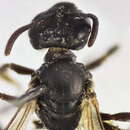en
names in breadcrumbs


This bee's nest architecture is described by Sakagami and Michener (1962). From Sakagami and Michener (1962): Nest architecture is Type IIIb: Lateral burrows are very short or absent such that cells are almost attached to the burrow walls at a right angle. The cells are not spatially concentrated in any part of the burrow. Sometimes a cavity surrounds the cells. Or nest architecture is Type IVb: Lateral burrows are very short or absent such that cells are almost attached to the burrow wall at a right angle. The cells are clustered against one wall and surrounded by a cavity created by burrowing around the entire cell cluster.
Plateaux-Quenu (2008) reviews the social behavior of Lasioglossum pauxillum. This species, which is widespread in the western paleartic, has two worker broods in the spring and summer. These are followed by a reproductive brood of males and females that will overwinter to be new nest foundresses the following spring. This species is thus eusocial, with reproductive queens and non-reproductive workers. Queens are generally larger than workers, although there is some overlap. Also, some males (~5% of brood) are produced along with the female worker brood. This species opens its cells to check on brood after oviposition.